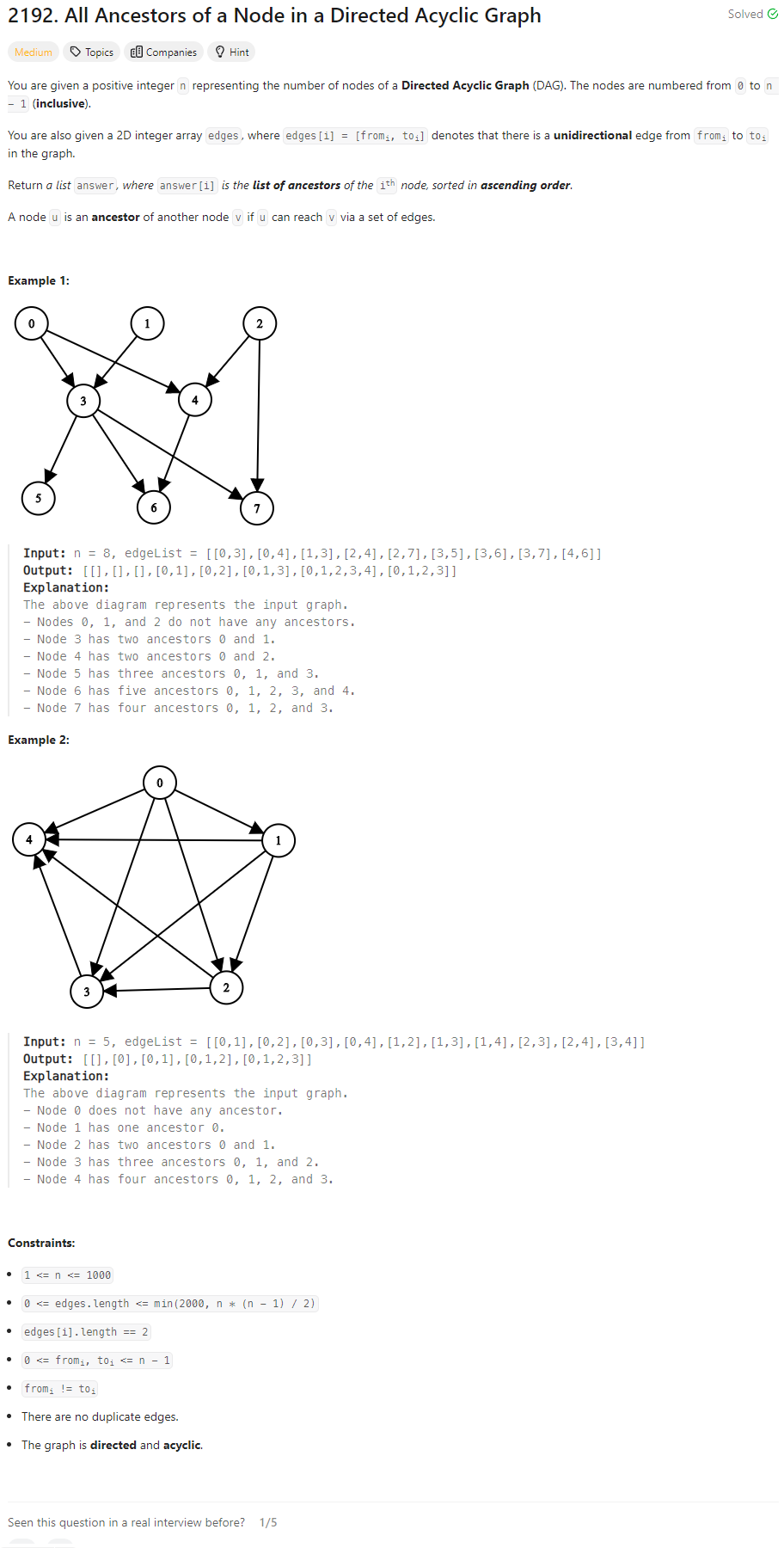Problem of The Day: All Ancestors of a Node in a Directed Acyclic Graph
Problem Statement

Intuition
To solve this problem, the key is to determine all the ancestors of each node in a directed acyclic graph (DAG). An ancestor of a node is any other node that has a path leading to that node. We can use depth-first search (DFS) to explore all paths leading to each node.
Approach
- Graph Representation: Represent the graph using an adjacency list where each node points to its direct ancestors.
- DFS Traversal: Use DFS to explore all ancestors for each node. Keep track of visited nodes to avoid redundant calculations.
- Result Compilation: Store and sort the list of ancestors for each node.
Complexity
-
Time Complexity:
- Constructing the graph: (O(E)), where (E) is the number of edges.
- DFS traversal: In the worst case, we visit all nodes for each node, resulting in (O(V^2)), where (V) is the number of nodes.
- Sorting ancestors for each node: (O(V \log V)).
- Overall, the time complexity is (O(V^2 + E + V \log V)).
-
Space Complexity:
- The space for storing ancestors: (O(V^2)) in the worst case.
- The space for the DFS stack and visited set: (O(V)).
- Overall, the space complexity is (O(V^2)).
Code
from collections import defaultdict
from typing import List
class Solution:
def getAncestors(self, n: int, edges: List[List[int]]) -> List[List[int]]:
ancestors = defaultdict(list)
# Build the graph with adjacency list
for src, dest in edges:
ancestors[dest].append(src)
# Function to perform DFS and find all ancestors of a node
def dfs(node, visited):
for ancestor in ancestors[node]:
if ancestor not in visited:
visited.add(ancestor)
dfs(ancestor, visited)
res = []
for i in range(n):
visited = set()
dfs(i, visited)
res.append(sorted(visited))
return res
Editorial
Approach 1: Depth First Search (Reversed Graph)
class Solution:
def getAncestors(self, n: int, edges: List[List[int]]) -> List[List[int]]:
# Initialize adjacency list for the graph
adjacency_list = [[] for _ in range(n)]
# Populate the adjacency list with reversed edges
for edge in edges:
from_node, to_node = edge
adjacency_list[to_node].append(from_node)
ancestors_list = []
# For each node, find all its ancestors (children in reversed graph)
for i in range(n):
ancestors = []
visited = set()
self.find_children(i, adjacency_list, visited)
# Add visited nodes to the current nodes' ancestor list
for node in range(n):
if node == i:
continue
if node in visited:
ancestors.append(node)
ancestors_list.append(ancestors)
return ancestors_list
# Helper method to perform DFS and find all children of a given node
def find_children(self, current_node, adjacency_list, visited_nodes):
# Mark current node as visited
visited_nodes.add(current_node)
# Recursively traverse all neighbors
for neighbour in adjacency_list[current_node]:
if neighbour not in visited_nodes:
self.find_children(neighbour, adjacency_list, visited_nodes)
Approach 2: Depth First Search (Optimized)
class Solution:
def getAncestors(self, n, edges):
# Initialize adjacency list for each node and ancestors list
adjacency_list = [[] for _ in range(n)]
ancestors = [[] for _ in range(n)]
# Populate the adjacency list with edges
for edge in edges:
from_node = edge[0]
to_node = edge[1]
adjacency_list[from_node].append(to_node)
# Perform DFS for each node to find all its ancestors
for i in range(n):
self.find_ancestors_DFS(i, adjacency_list, i, ancestors)
return ancestors
# Helper method to perform DFS and find ancestors
def find_ancestors_DFS(
self, ancestor, adjacency_list, current_node, ancestors
):
for child_node in adjacency_list[current_node]:
# Check if the ancestor is already added to avoid duplicates
if (
not ancestors[child_node]
or ancestors[child_node][-1] != ancestor
):
ancestors[child_node].append(ancestor)
self.find_ancestors_DFS(
ancestor, adjacency_list, child_node, ancestors
)
Approach 3: Topological Sort (BFS)
class Solution:
def getAncestors(self, n, edges):
# Create adjacency list
adjacency_list = [[] for _ in range(n)]
# Fill the adjacency list and indegree array based on the edges
indegree = [0 for _ in range(n)]
for edge in edges:
from_node = edge[0]
to = edge[1]
adjacency_list[from_node].append(to)
indegree[to] += 1
# Queue for nodes with no incoming edges (starting points for topological sort)
nodes_with_zero_indegree = [i for i in range(n) if indegree[i] == 0]
# List to store the topological order of nodes
topological_order = []
while nodes_with_zero_indegree:
current_node = nodes_with_zero_indegree.pop(0)
topological_order.append(current_node)
# Reduce indegree of neighboring nodes and add them to the queue
# if they have no more incoming edges
for neighbor in adjacency_list[current_node]:
indegree[neighbor] -= 1
if indegree[neighbor] == 0:
nodes_with_zero_indegree.append(neighbor)
# Initialize the result list and set list for storing ancestors
ancestors_list = [[] for _ in range(n)]
ancestors_set_list = [set() for _ in range(n)]
# Fill the set list with ancestors using the topological order
for node in topological_order:
for neighbor in adjacency_list[node]:
# Add immediate parent, and other ancestors.
ancestors_set_list[neighbor].add(node)
ancestors_set_list[neighbor].update(ancestors_set_list[node])
# Convert sets to lists and sort them
for i in range(n):
ancestors_list[i].extend(ancestors_set_list[i])
ancestors_list[i].sort()
return ancestors_list